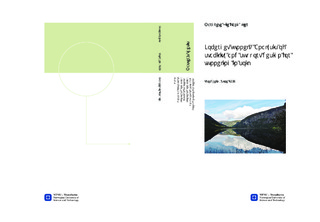Joberget tunnel - Analysis of stability and support design for tunneling in soil
Master thesis
Permanent lenke
http://hdl.handle.net/11250/236339Utgivelsesdato
2014Metadata
Vis full innførselSamlinger
Sammendrag
The Norwegian Public Roads Administration (NPRA) is planning a construction of a new road tunnel, Joberget tunnel in the Granvin Municipality of western Norway. Approximately 80 m from the southwestern entrance of the tunnel will be excavated, partly in soil and partly in rock. Soil tunneling will be performed in this section instead of excavation of large open cuts, to avoid difficult work conditions, landslide hazards and severe landscape interventions. Sweco Norge AS in cooperation with the Austrian company iC Consulenten from Austria are contracted to consult the soil tunneling section of Joberget tunnel. This thesis is a continuation of a project assignment carried out in 2013 and analyses stability and support design of Joberget soil tunnel, based on empirical and numerical methods. Empirical studies of Joberget soil tunnel include a study of experiences with soil tunneling and a rock mass classification based on the Q- and RMR-system. The importance of additional support in soil tunneling is due to instability of tunnel face, unsupported span and water leakage is revealed in this study. The pipe umbrella primary support method, providing reinforcement of tunnel heading, is found favorable when tunneling in similar ground condition as is present at Joberget.The numerical analysis is performed with a two-dimensional finite element method in Phase2. Evaluation of the total displacement is used to investigate the stability of the proposed design of Joberget soil tunnel, in both cross section and longitudinal section. The pipe umbrella support method is simulated by an improved material layer which shows the supporting effect of the pipe umbrella. Additionally, numerical analyses reveal that subdivision of face, short round lengths and installation of permanent support immediately after excavation are favourable during soil tunneling. The greatest limitation in numerical modelling is the reliability of the input parameters. Hence, a parameter study on moraine properties and field stresses is carried out. Young s Modulus, E is found to be the most sensitive parameter. To supplement the estimation of E, triaxial testing on the moraine material is performed. The reducing effect of water onto material strength is demonstrated by the triaxial test and the numerical analysis. With a well prepared drainage plan, careful excavations and additional support measures such as the pipe umbrella method, soil tunneling in Joberget is considered to be feasible. However, the stability analyses include several simplifications and uncertainties. A detailed follow-up and monitoring during tunneling is therefore important to verify the model and to find the required support.
